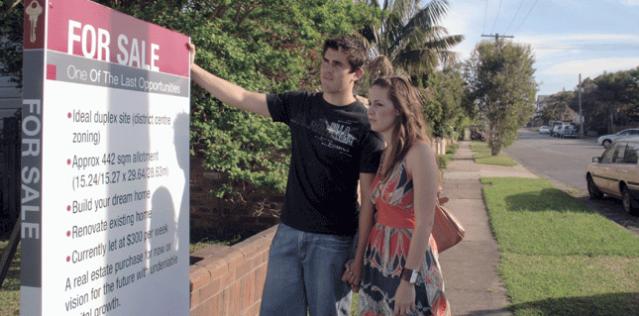
©The Cairns Post
Q1. Why are house prices in urban Australia perpetually rising?
ANSWER:
Demand for housing exceeds supply, particularly in the capital cities. Real estate investors, the real estate industry and property developers seek to maximise their capital gain on selling housing and so seek the highest price on an open unregulated market.
Q2. Why is demand for urban housing exceeding supply in Australian cities?
ANSWER:
Population growth is outpacing the combined rate of sales of existing housing and construction of new housing in the capital cities.
Q3. Why is housing demand so strong?
ANSWERS:
Australian federal and state governments are encouraging business development in the capital cities and so employment opportunities are disproportionately higher in the capital cities. Australian federal and state governments are encouraging urban population growth at rates that exceed the housing supply in the capital cities. Since employment opportunities are disproportionately higher in the capital cities, population growth is disproportionately high in the capital cities.
Q4. Why is housing supply in capital cities not meeting demand?
ANSWER:
Housing in the capital cities is not becoming available at a rate that can keep up with population growth. Housing is not being constructed fast enough to cater for the increased demand in the capital cities. Even when mass housing construction is released, governments are not funding appropriate residential/social infrastructure - schools, public transport, emergency services, recreational facilities, etc to maintain quality of life comparable to established suburbs.
Q5. Why is Australia's population growth so high?
ANSWER:
Net immigration growth is the bulk of the population growth and this is being perpetually and recklessly encouraged by successive pendulous cycle of Lib/Lab political parties with vested interests in the short term profits of growth.
Comment:
The sheer volume of immigrants to Australia are -over-demanding housing forcing housing scarcity and price rises making housing unaffordable to Australians. Governments are encouraging urban property price increases - through excess immigration, and urban-centric economic stimulus, yet all the while neglecting social responsibility for providing urban capacity. As Sheila Newman states on CanDoBetter: "Here in Australia every state government is in the business of raising the price of land beyond the capacity of most people to pay for it, creating exorbitant rents."
Just because many foreign governments allow excessive populations, this does not mean that Australia has to accept foreigners seeking a better opportunity. Beyond Australia's humanitarian obligations to accept refugees fleeing persecution, Australia does not have to accept economic migrants. It is these economic migrants who are displacing Australians from housing, employment, education. Economic migrants are not paying their way and are draining tax revenue to the detriment of indigenous and local Australians.
Once Australia's homeless have a humanitarian safety net of food, shelter, clothing, medical care and educational opportunity, only then should Australia consider extending invitations to foreigners to share the Australian dream of owning one's own home, but then only if carrying capacity permits.
"105,000 Australians are homeless on any given night."
[Source:Homelessness Australia]
This is a national disgrace! It is as if Australia has a 'Migrant First Policy'.
Australian Per Capita Self-Reliance Cost
What is the cost to house, feed, shelter, clothe, provide medical care, educate in literacy and numeracy a person in Australia to enable that person to become independently self-reliant and at an acceptable Australian quality standard of living? From birth to say age 22 when tertiary education will prepare a person for the workforce in the 21st Century, let's say the per capita cost is $1 million. In addition, the costs of providing social infrastructure and economic opportunities to nurture and support one's stable family environment would need to be included. Let's say the per capital cost is then $1.3 million for argument sake.
It thus costs $1.3 million in Australian taxes to get each Australian-born to a minimum self-reliance standard. Many of course will require more resources and time to achieve this and those who are disadvantaged may never reach this ideal standard, so the costs will be higher.
It is with this reality in mind that Australia's social policy and immigration policy needs to be fully realised and publicly costed. The fact that this is deliberately neglected by cyclical Lib/Lab governments at all levels that Australia's living standards are rapidly approaching those of 'Second World' New Zealand.
New Zealand a 'Second World' nation you ask?
Well, the term traditionally referred to Eastern Bloc countries, but times have changed. The term more usefully refers to countries that on the basis of economic prosperity, living standards and quality of life lie between the First World (like most of Western Europe) and the Third World (like most of Africa). Some Third World countries like Malaysia are advancing, while some First World countries like New Zealand are going backwards.
"An international report has found that a sixth of New Zealand children are being raised in poverty - a higher rate than in all but three of the world's 26 rich nations.
The Innocenti Research Centre, established by the United Nations Children's Fund (Unicef), says 16.3 per cent of New Zealand children in 2001 lived in homes that earned less than half the national median income.
Only Mexico, the United States and Italy had higher rates of child poverty."
[Source: 'NZ's child poverty rate one of highest', NZ Herald, Simon Collins, 2nd March 2005].
Further Reading:
Read More about the 'Second World' by author Parag Khanna in his book 'The second world: empires and influence in the new global order.'. Khanna claims this Second World comprises Eastern Europe, Central Asia, Latin America, the Middle East, and East Asia, emerging Third World countries such as Azerbaijan, Uzbekistan, Colombia, Libya, Vietnam, and Malaysia.
However, just as some Third World ('developing') countries are advancing, there are some presumed 'First World' (developed) countries that have allowed their economies and societies to slip below modern First World socio-economic health standards. These include New Zealand, Greece, South Africa, Zimbabwe, Russia, and Portugal. We may refer to retrograde socio-economic as 'nation backsliding'.
The measures determining a country's socio-economic health include a factor of Physical quality-of-life index (PQLI) derived from basic literacy rate, infant mortality, and life expectancy at age one, all equally weighted on a 0 to 100 scale. The measures are also a factor of Gross National Product (GNP) as a measure of comparative economic performance and the UN Human Development Index (HDI) as a comparative measure of poverty, literacy, education, life expectancy, childbirth, and other factors for countries worldwide. HDI measures the average achievements in a country in three basic dimensions of human development:
A long and healthy life, as measured by life expectancy at birth.
Knowledge, as measured by the adult literacy rate (with two-thirds weight) and the combined primary, secondary, and tertiary gross enrolment ratio (with one-third weight).
A decent standard of living, as measured by gross domestic product (GDP) per capita at purchasing power parity (PPP) in USD.
Each year, UN member states are listed and ranked according to these measures. Those high on the list often advertise it, as a means of attracting talented immigrants (economically, individual capital) or discouraging emigration.
An alternative measure, focusing on the amount of poverty in a country, is the Human Poverty Index.

 In a media release on 17 July 2023, Annette Brownlie of the Independent and Peaceful Australia Network (IPAN) welcomed the decision by India not to particpate in the 'Talisman Sabre military exercises which were scheduled to be held from 22 July in Queensland's Shoalwater Bay. Other participants are New Zealand, Australia and the United States.
In a media release on 17 July 2023, Annette Brownlie of the Independent and Peaceful Australia Network (IPAN) welcomed the decision by India not to particpate in the 'Talisman Sabre military exercises which were scheduled to be held from 22 July in Queensland's Shoalwater Bay. Other participants are New Zealand, Australia and the United States.
 What can we learn by contrasting Kim Dotcom's experience fighting extradition to the US with Julian Assange's? Watch this fascinating documentary and think about it.
What can we learn by contrasting Kim Dotcom's experience fighting extradition to the US with Julian Assange's? Watch this fascinating documentary and think about it.




Recent comments